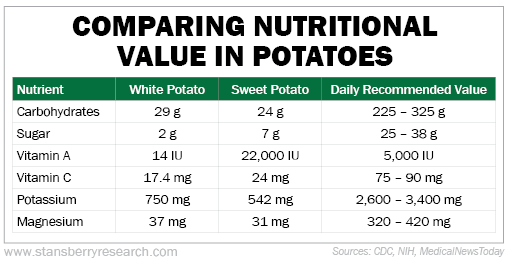I learned a valuable lesson recently... People really love their potatoes.
Last month, I wrote that one way for folks to keep their hearts healthy is to avoid "white killers" like white sugar, white rice, and potatoes.
I'm no stranger to controversy. But the angry e-mails after I shared this advice shocked me...
Lots of folks said my views on potatoes are outdated and that their beloved spuds contain lots of nutrients.
I want to be clear: I'm not telling you to completely give up your potatoes. After all, the potato is one of the most-consumed foods in the world. Here in the U.S., we each eat about 117 pounds of potato every year on average.
But you do need to understand the pros and cons...
White potatoes are a great source of fiber and potassium. They contain about 750 mg of potassium... or about 20% of your recommended daily intake.
But sweet potatoes pack even more nutrients. They contain plenty of vitamin A, which we need for eye health and strong immune systems. Take a look at how white potatoes stack up against sweet potatoes. These figures compare medium-sized skin-on spuds...

Although sweet potatoes have lower levels of potassium and magnesium, they also contain around 43 mg of calcium, which is about 3.5% of your daily recommended intake.
Here's why I put potatoes (white and russet) in my list of "white killers"...
The problem is blood sugar. To illustrate that, I'll use the glycemic index ("GI"). It's a scale that measures how much the carbs in a certain food increase your blood sugar.
Glucose itself ranks at 100. Foods high on the index spike your blood sugar. That's dangerous over time, particularly for folks with diabetes.
Let's take a look at the most common example of a white potato – a russet. A baked russet potato has a GI of 111. That's one of the highest-rated foods possible. In fact, in a study from the journal Diabetes Care, researchers calculated the glycemic indexes of more than 1,000 foods... and russet potatoes had one of the highest numbers in the entire list.
A baked sweet potato, on the other hand, only has a GI of 70. That's still higher than some other vegetables (parsnips, for instance, are 52). But it's much lower than the russet.
Now, I know what you're thinking... We've previously discussed the problems with solely using a GI measurement.
Glycemic load ("GL") is a better measure of what your body actually does. That's because GL measures how much your blood sugar rises based on serving size.
It involves multiplying the GI by the number of carbs in a serving, then dividing by 100. So while that russet potato has a GL of 33, a sweet potato has a GL of 22. Anything with a GL more than 20 is considered high, but even here, sweets beat out the russets.
There's another factor... If you're one of the 168 million Americans taking a blood-pressure medicine called an ACE inhibitor (that's angiotensin-converting enzyme), you might want to reconsider eating white and russet potatoes.
As I mentioned earlier, white potatoes are a great source of potassium. However, ACE inhibitors cause the body to retain potassium instead of filtering it out through the kidneys. That's why kidney disease also results in potassium buildup. Too much potassium leads to a condition called hyperkalemia, which causes symptoms ranging from muscle weakness to dangerous, irregular heartbeats.
Popular ACE medications include Lotensin, Capoten, and Vasotec. If you're taking one, make sure your doctor monitors your potassium level regularly. If it's high, cut out the potatoes.
When I'm eating potatoes, I go for either sweet potatoes or purple/blue potatoes.
Purple potatoes contain an antioxidant known as anthocyanin that can lower inflammation, reducing your risk of heart disease and cancer. Not all big chain stores carry purple potatoes. But you can find them at Whole Foods or gourmet-food stores.
Whatever you do, don't fry your potatoes too often. In 2017, Researchers from the U.K.'s Food Standards Agency confirmed that cooking starchy foods like potatoes at high heat leads to the formation of a chemical called acrylamide. The "crispier" the potatoes, the higher the amount of acrylamide. Frying produced the highest amount of the chemical.
Research suggests acrylamide leads to certain cancers. Now, we know that it takes a lot of acrylamide to do damage (remember our California coffee cops)... but with all the trans fat that triggers inflammation, we're happy to throw our potatoes on the grill instead.
So don't worry, dear readers... You can still enjoy potatoes, particularly if you need a good source of potassium. But limit your consumption, particularly if you have blood sugar control issues.
And maybe give sweet potatoes a chance – my researcher likes them with just a little butter and cinnamon. And I like to grill up purple potatoes sliced (like a chip), brushed with a little olive oil, and sprinkled with fresh rosemary.
What We're Reading...
- In case you missed it... Today feels like the 1970s all over again.
- Something different: The downfall of the pandemic's stock market darling – Peloton.
Here's to our health, wealth, and a great retirement,
Dr. David Eifrig and the Health & Wealth Bulletin Research Team
February 15, 2022
